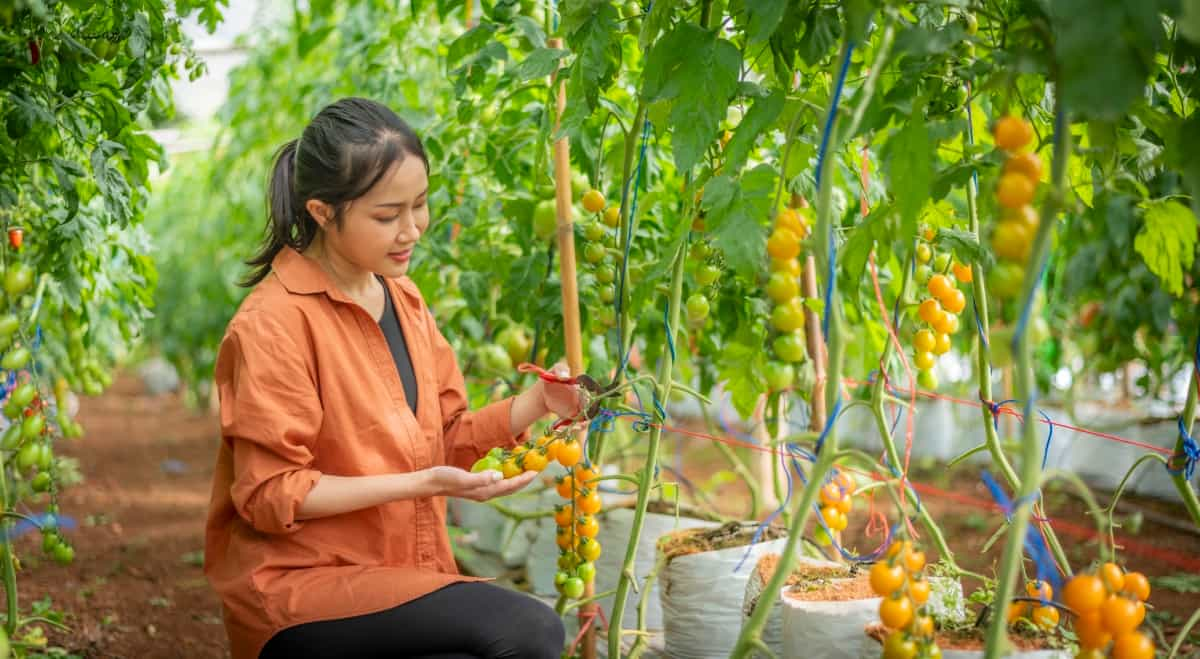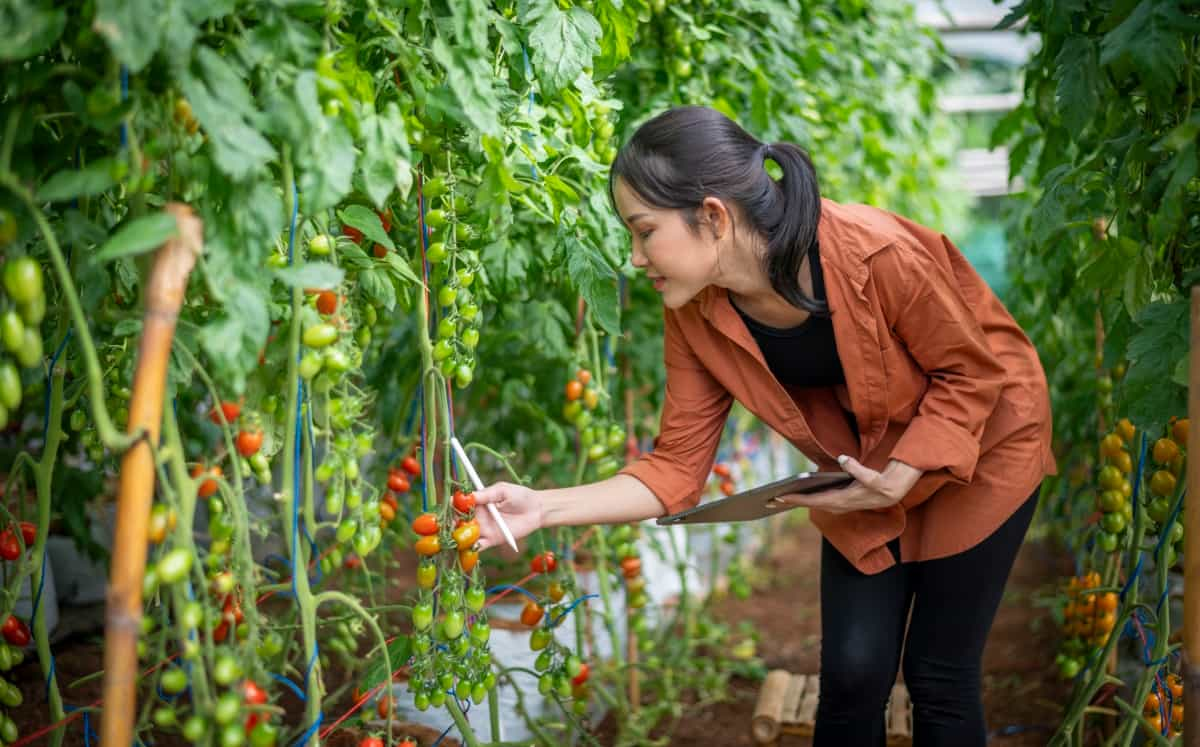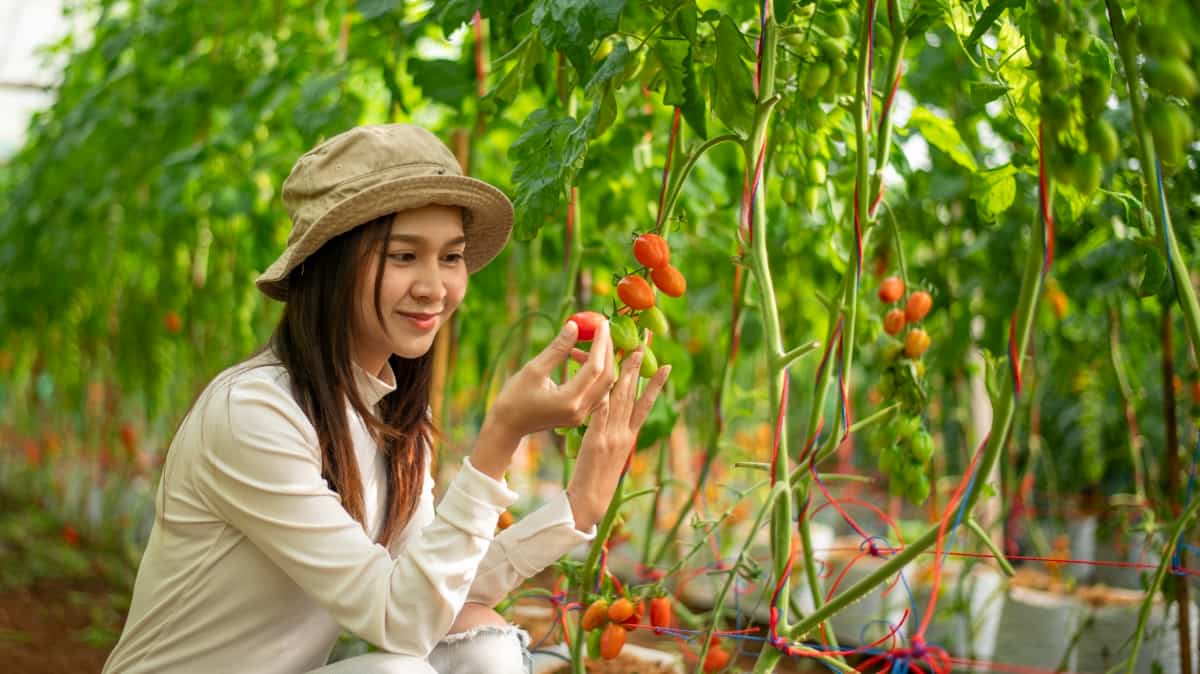Greenhouse Cherry Tomato farming is a method of growing Cherry Tomatoes in a controlled environment, such as a greenhouse. Unlike traditional outdoor farming, this technique allows farmers to create the ideal conditions for optimal plant growth and fruit production. The greenhouse Cherry Tomato farming lies in its ability to extend the growing season and increase yield.

Greenhouse Cherry Tomato Farming
Choosing the Right Greenhouse Structure
There are various factors to consider when selecting the right greenhouse structure for growing Cherry Tomatoes. Firstly, assess the available space and determine how many Cherry Tomato plants you plan to grow. This will help you determine the size of the greenhouse you need. Next, consider the climate in your area. If you live in an area with extreme weather conditions like high winds or heavy snowfall, a sturdy and durable greenhouse structure is essential. Another factor to consider is ventilation.
Cherry Tomato production in a greenhouse thrives in well-ventilated environments, so choose a greenhouse structure that allows for proper airflow through vents or windows. To successfully grow Cherry Tomatoes in a greenhouse during winter, starting with high-quality seeds or seedlings is crucial. Choose varieties that are specifically bred for indoor cultivation and have shorter maturation periods. Investing in a high-quality greenhouse structure may require a larger initial investment but can provide better durability and longevity.
Preparing the Greenhouse Site
Cherry Tomatoes thrive in full sun exposure, so make sure your chosen site gets at least 6-8 hours of direct sunlight daily. Next, prepare the soil by removing weeds from the area. Good drainage is essential, as excessive moisture can lead to fungal diseases. Spacing for Cherry Tomatoes in a greenhouse is also crucial for maximizing yield.
Most experts recommend maintaining a spacing of around 18-24 inches between plants within rows. Consider installing shade cloth or blinds if you live in an area with intense heat or strong winds. With these right techniques and strategies, it is possible to increase the yield of Chery Tomatoes in a greenhouse.
Setup Irrigation Systems for Greenhouse Cherry Tomato Farming
Proper watering is important for the healthy plant growth. There are different types of irrigation systems available, such as drip irrigation, overhead sprinklers, or a combination of both. Drip irrigation is widely used in growing Cherry Tomatoes in the greenhouse because it provides water directly to the roots, minimizing water wastage and reducing the diseases caused by excess moisture on foliage.
It also helps maintain optimal soil moisture levels and prevents fluctuations that can stress the plants. When setting up drip irrigation, it’s important to consider factors like spacing between emitters, flow rate, and duration of watering sessions.
Provide Nutrients and Fertilizers
Cherry Tomatoes require a balanced combination of macro and micronutrients for optimal development. To begin, soil testing is essential to determine the nutrient deficiencies in your greenhouse Cherry Tomato farming. Based on the results, you can then formulate a customized fertilization plan. This will help address any specific needs of your Cherry Tomato plants.
In case you missed it: Chocolate Cherry Tomato Overview: Taste, Size, History, Origin, Growing, and Yield

Organic fertilizers, like compost or manure, are often preferred in greenhouse farming as they enhance soil structure and promote long-term sustainability. Moreover, foliar feeding can be beneficial for quick nutrient uptake by the plants through their leaves.
Control Pests and Diseases
Aphids, Whiteflies, Tomato hornworms, Fusarium wilt, and Early blight are the most important pests that affect Cherry Tomatoes. Practicing good sanitation is crucial. Monitor your Cherry Tomato plants regularly for any signs of pest infestation or disease symptoms. Early detection is key to successful control. Watch for common tomato pests such as aphids, whiteflies, spider mites, and caterpillars. Additionally, neem oil or insecticidal soap sprays can be used as a natural deterrent.
In terms of diseases, fungal infections like powdery mildew and blight are common in greenhouses. Applying fungicides specifically formulated for tomatoes can also help protect against fungal diseases. Remember that pest prevention is better than cure for controlling pests and diseases in your greenhouse Cherry Tomato farm.
Carryout Pruning and Training
Plant pruning involves selectively removing certain parts, such as lateral shoots or leaves, to promote better air circulation and light penetration. This helps prevent diseases and ensures optimum nutrient distribution throughout the plant. Training, on the other hand, involves guiding the plants’ growth by using trellises or stakes. By providing support for the vines, you can prevent them from sprawling on the ground, which reduces disease risks and makes harvesting easier.
Pollinating Cherry Tomato Plants
To ensure successful pollination in your greenhouse Cherry Tomato farm, you can use several methods. One popular technique is hand pollination, where you gently shake or tap each flower cluster to release the pollen onto the stigma. Another method involves using an electric toothbrush or small paintbrush to transfer pollen between flowers. The best time for hand pollination is early morning when temperatures are cooler. It’s important to note that not all varieties of Cherry Tomatoes require manual pollination in a greenhouse.
Picking Cherry Tomatoes on Time
Cherry Tomatoes should have a vibrant red hue when they are fully ripe. The green parts of the fruit should be minimal or absent altogether. Next, gently squeeze the tomato between your fingers. A ripe Cherry Tomato will give slightly under pressure without being too soft or mushy. Another indicator of readiness for picking is the ease with which the fruit detaches from the vine.
If it comes off easily with a gentle tug, then it’s ready to be plucked. It’s important not to wait too long before harvesting, as overripe tomatoes can become mealy and lose their sweet taste. On the other hand, picking them too early may result in a lack of flavor development.
Selling Greenhouse Cherry Tomatoes
Once you have successfully grown your beautiful Cherry Tomatoes in the greenhouse, it’s time to think about selling them and reaping the rewards of your hard work. Selling greenhouse Cherry Tomatoes can be a lucrative venture if done right. It’s important to identify your target market. Next, consider packaging options that will showcase the vibrant colors and freshness of your Cherry Tomatoes. To attract customers, focus on marketing efforts such as creating eye-catching signage and promoting your products through social media channels.
In case you missed it: Frequently Asked Questions About Growing Cherry Tomatoes from Seed to Harvest

Greenhouse Cherry Tomato Farming Profit
The yield of Cherry Tomatoes in a greenhouse can vary depending on many factors like variety, climate control, nutrient management, and pruning techniques. On average, one acre of greenhouse Cherry Tomato farming yield can produce around 20-30 tons of tomatoes annually. Considering that wholesale prices range from $2-$4 per pound (depending on quality), you can do the math to estimate your potential earnings.
The market demand for fresh Cherry Tomatoes remains strong due to their exceptional taste and versatility in culinary applications. On average, though, farmers have reported earning between $20k – $40k from an acre of greenhouses with Cherry Tomatoes annually.
Greenhouse Cherry Tomato Farming Cost
The cost of setting up a greenhouse for Cherry Tomato cultivation depends on various factors, including the size of the structure, materials used, equipment needed (such as heating and ventilation systems), irrigation systems, and soil amendments. Additionally, labor costs should also be taken into consideration.
Greenhouse Cherry Tomato farming can be a lucrative venture, but it’s essential to understand the costs involved and the potential profits you can expect per acre. The initial setup cost of a greenhouse for Cherry Tomato farming can vary depending on its size and the materials used. On average, the average total production cost of greenhouse cherry tomatoes is around $20,000 to $50,000.
In case you missed it: 10 Best Cherry Tomato Varieties You Should Grow in Your Garden

Conclusion
In greenhouse Cherry Tomato farming, plants are grown inside specially designed structures that protect them from harsh weather conditions and pests. These structures can be made of glass or plastic, allowing sunlight to penetrate while also retaining heat. By providing a favorable environment for the plants, farmers can grow tomatoes year-round and produce higher quantities of delicious cherries.
- Feed Your Flock for Less: Top 10 Tips to Save on Chicken Feed
- Ultimate Guide to Ossabaw Island Hog: Breeding, Raising, Diet, and Care
- Hatching Answers: The Top 10 Reasons Your Chickens Aren’t Laying Eggs
- Eggs and Economics: Breaking Down the Cost of Raising Backyard Chickens
- Defend Your Greens: Proven Methods to Keep Iguanas Out of Your Garden
- Ultimate Guide to Cinnamon Queen Chicken: A Comprehensive Guide for Beginners
- Ultimate Guide to California Tan Chicken: Breeding, Raising, Diet, Egg-Production and Care
- Ultimate Guide to Marsh Daisy Chicken: Breeding, Raising, Diet, and Care
- 10 Types of Chicken Farming Businesses You Can Start for Profits